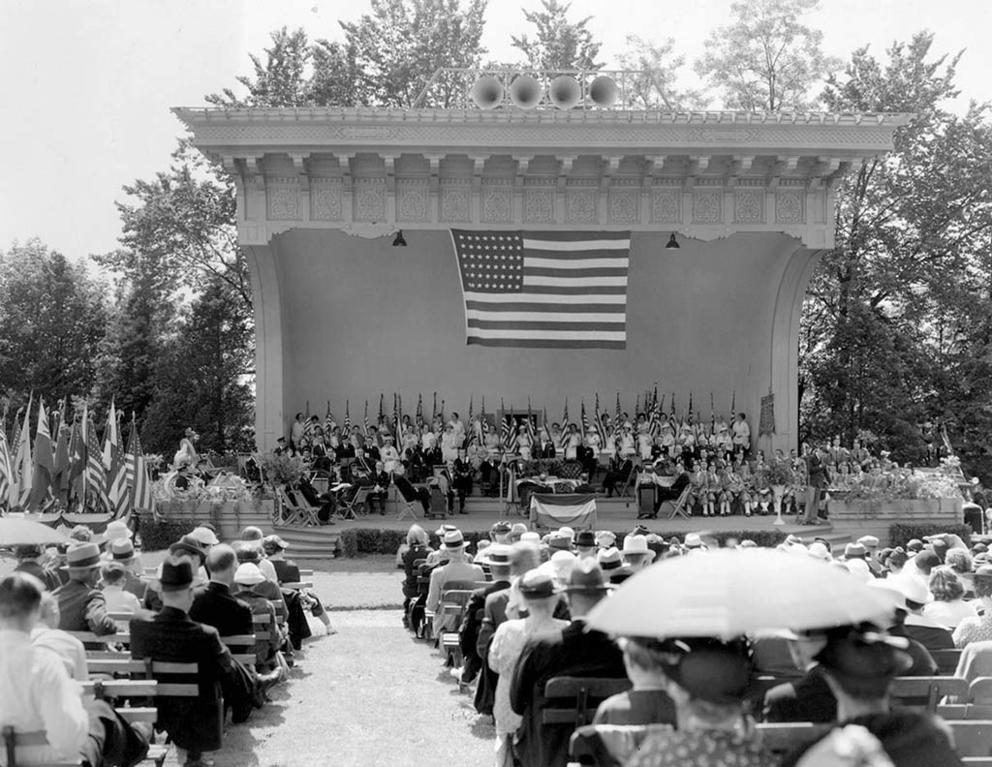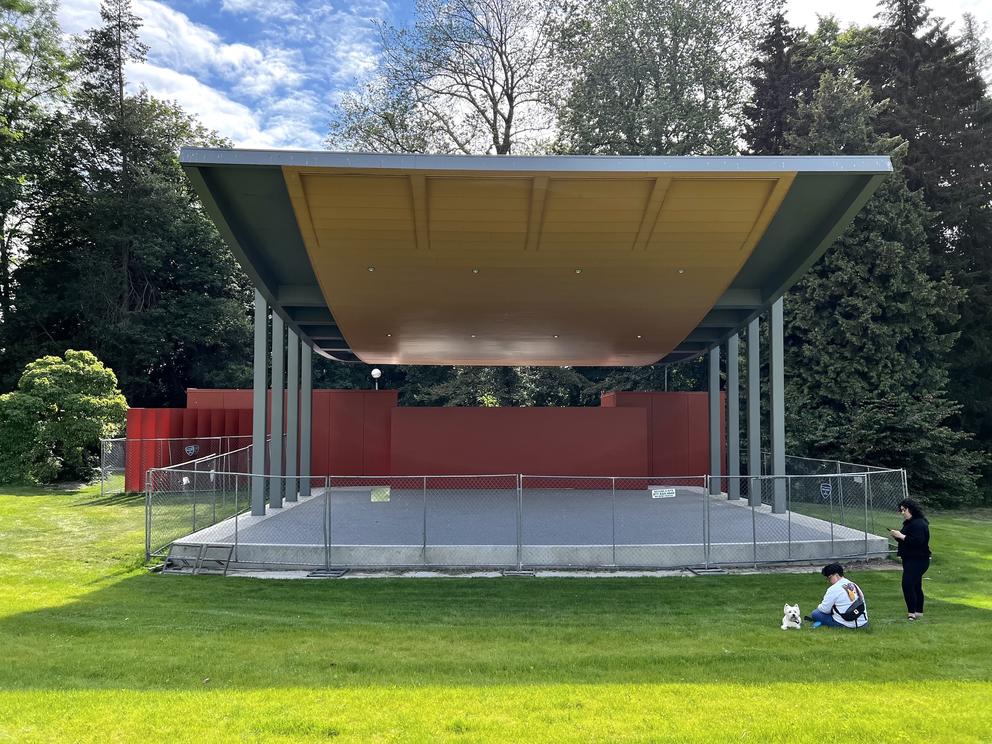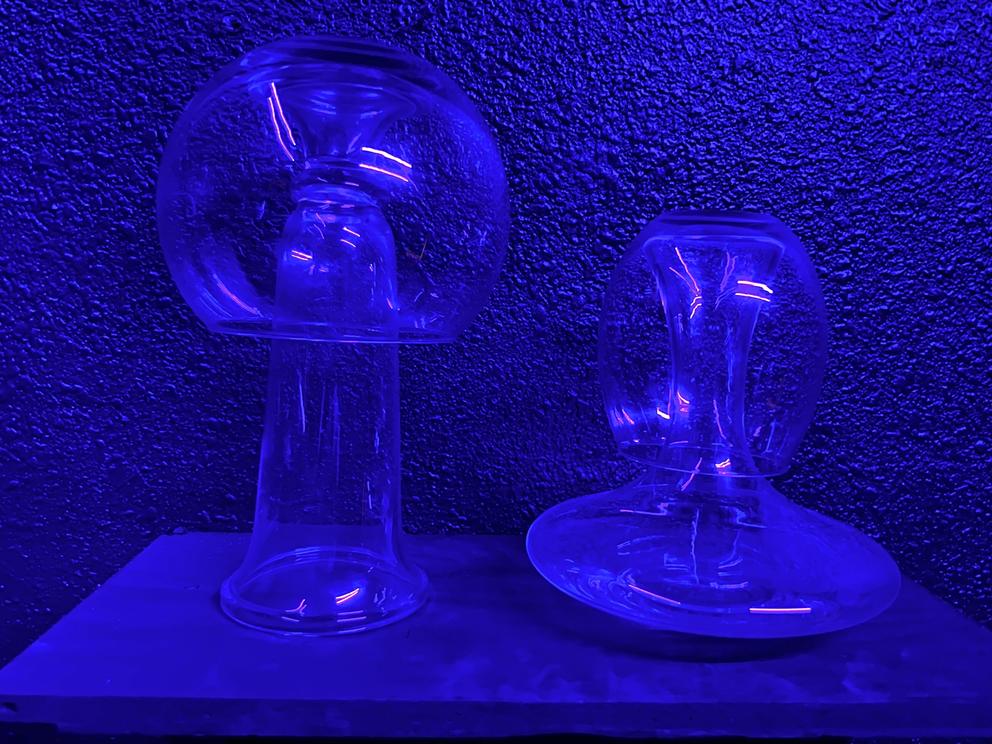In the historic photos (see a few fascinating shots on Historylink), the concert grove looks like a lovely place to listen to music on a summer evening. But local musicians — who apparently held more infrastructural sway in that era — complained that the space was too small and requested a proper bandshell. They got one in 1915, just north of the reservoir, in the spot most of us here in the 21st century know as the amphitheater.
ArtSEA: Notes on Northwest Culture is Crosscut’s weekly arts & culture newsletter.
The original wooden bandshell was a beautiful structure — a big white wave that appears to crest over the musicians — designed by Carl F. Gould, founder and first chair of the architecture program at the University of Washington. Gould also designed the original Seattle Art Museum (now the Seattle Asian Art Museum), built in 1931-1933 on the spot where the concert grove and pergolas previously stood.
By the end of World War II, the old bandshell had fallen into disrepair and was torn down in 1947. For the next couple decades, a temporary structure sufficed as a stage. It wasn’t much more than a raised wooden-plank platform, judging by photos from 1967’s “Be-In” festival, where, according to a contemporaneous Seattle Times report, “Costumed hippies listened to jazz and folk-rock music…. lolled on the lawn enjoying brief glimpses of sunshine and bathed themselves in the music. Some of the young people strummed guitars, others smoked bubble pipes and many ate from sack lunches.” Just as the Olmsted Brothers intended.
Perhaps the hippie invasion inspired a fresh look at Volunteer Park. In 1971, Seattle landscape architect Richard Haag was hired to rework a few aspects, including stretching the art museum’s entrance plaza to connect better with Isamu Noguchi’s “Black Sun” (installed in 1969). He also designed the (highly!) minimalist concrete and brick amphitheater stage that stood for 50 years.
While it showcased countless music, theater and dance performances, that trapezoidal stage was neither inspiring nor terribly functional. (Maybe Haag’s attention was focused on his genius reimagining of Gas Works Park, which he was also working on at the time.) In 2021, Haag’s stage was demolished to make way for a new era in live performance at Volunteer Park.
This weekend marks the grand opening of Volunteer Park Trust’s long-planned, $3 million amphitheater stage and regraded lawn, designed by ORA Architects and Walker Macy Landscape Architects. While the design is still fairly minimalist, the new stage does have several cool features, including a back wall that can pivot to create an open pavilion and foot-friendly flooring for professional dance. And as with Gould’s bandshell, the performers are protected from the soggier elements by a roof — but one that swoops upward instead of over.
Check it out for yourselves during the many performances slated for this summer, including outdoor Shakespeare and outdoor movies. The opening weekend festivities (July 2, 2-7 p.m.) feature a day full of local music, including Taiko Kai, Brittany Davis and LeRoy Bell and His Only Friends. That same evening (July 2, 7 p.m.) the Seattle Chamber Music Society’s Concert Truck pulls up (fresh off its 11 a.m. performance at Victor Steinbrueck Park) to perform classical works that might well have been heard back in the old concert grove 110 years ago.
It’s July 4th weekend, but the recent slate of Supreme Court decisions has many of us feeling more blue than red-white-and-blue. If we shift from the mood to the color, however, we can bask in blue’s beauty, resonance and symbolism.
Take for example Blue Is Our Color (opening celebration July 2, 5-8 p.m.; on view through Oct. 7) a group show at Hedreen Gallery on the Seattle University campus. “Blue contains whole worlds in its shades,” writes Seattle artist and exhibit curator Adetola Abatan. “The twinkle of sapphires, the inky hues of a storm at sea, or the spotted simplicity of a robin’s egg.”
The broad spectrum of blue is why she chose it as the theme for this exhibit, subtitled “Black Memory, Identity and Protest.” Abatan told me the show’s inspiration came to her as a student in SU’s Arts Leadership MFA program (from which she graduated this year). She wondered what it might look like to bridge past, present and future stories of the African and Black diaspora through art.
The answer: indigo-dyed and stitched Àdìrẹ patterns, sourced from Nigeria; a softly sewn fabric collage by Seattle artist Jite Agbro; deep blue woven textiles from Mali; Marin Alexis Burnett’s haunting and holy imagery based on missing Black women; Brian LaMar’s inky cyanotype photographs from the 2020 police brutality protests in Seattle; and swirling blue (and pink and yellow) paintings by local artist Moses Sun. As it tells a story that stretches across continents, the collection is sometimes serene as a picnic blanket and sometimes crackles like firecrackers.
And a couple more ways to embrace a “mood indigo”…
The En Gallery, an eclectic pop-up in a vacant Columbia City storefront, has been active for the past several months with unpredictable hours. Thankfully, the raw space has established fixed hours (noon-4 p.m. Saturday and Sunday), which makes it easier to stop by and see the excellent new group show …and so it goes (up through July 31). Head in to see Seattle artist Allyce Wood’s impressive series of woven jacquard tapestries, created on a digital loom in Norway. Pieces like “Semi Set Vertical Blu” blend ages-old weaving techniques with high-tech machinery and rolling waves of blue.
Slip behind the heavy curtain at the back of The En and you’ll find yourself in a dark undersea setting. Longtime local artist Christian French’s clever immersion, Jellarium, features a school of globular sea creatures crafted from household glassware. A trick of black light turns everything bioluminescent blue-purple, offering a momentary escape from summer heat and current events.
Get the latest in local arts and culture
This weekly newsletter brings arts news and cultural events straight to your inbox.






